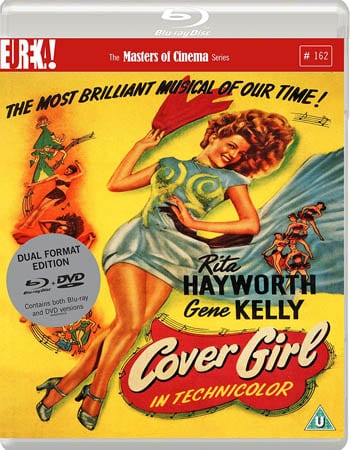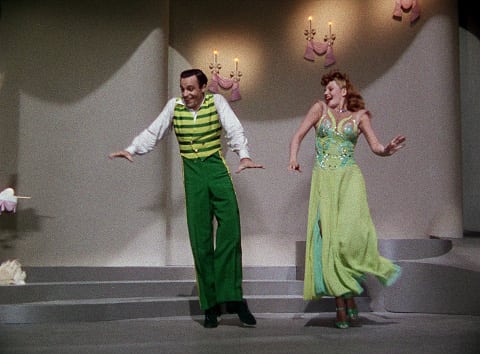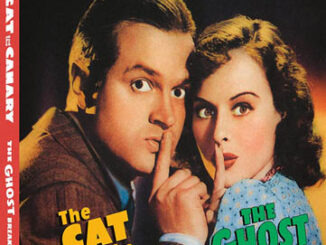Cover Girl (1944)
Directed by: Charles Vidor
Written by: Marion Parsonnet, Paul Gangelin, Virginia Van Upp
Starring: Gene Kelly, Lee Bowman, Phil Silvers, Rita Hayworth
USA
AVAILABLE ON DUAL FORMAT BLU-RAY AND DVD: NOW, from EUREKA ENTERTAINMENT
RUNNING TIME: 107 min
REVIEWED BY: Dr Lenera, Official HCF Critic
Rusty Parker is a dancer who works at a nightclub ran by her boyfriend Danny McGuire. She auditions to be a highly paid cover girl, and after flunking her first audition due to the mechanics of her fellow dancer and competitor Maureen Martin, is given another chance when the magazine editor John Coudair sees that she greatly resembles of a girl he lost and loved in his youth, showgirl Maribelle Hicks, who was actually Rusty’s grandmother. Rusty would faithfully remain with her nightclub act if only Danny would ask her, but Danny doesn’t want to tell her what to do and Rusty sets off on a path to stardom, a path complicated further when she gains another suitor in the form of wealthy theatre producer Noel Wheaton….
Having like so many other people fallen in love with La La Land, I’ve been exploring the musical genre a bit of late, and I was very glad when Eureka Entertainment released Cover Girl, a bouncy, romantic offering starring the Love Goddess herself, a woman who to my mind was one of the beautiful women who ever appeared on the screen, a woman whose combination of vulnerability, sexiness and poise has rarely been matched. The film seems to be regarded more as the picture that made Hayworth and Gene Kelly, both of whom had been around for a few years, into big stars, and as a dry run for the great musicals of the 50’s, rather than a genre classic in its own right, but I had a pretty good time watching it. The story can be considered as fluff and merely filler for the song and dance numbers, and it was probably old-hat when the film was made, but it does ask important, if hardly unfamiliar questions, such as is fame all that it’s cracked up to be, and is less really more if you are happy? As plush looking as your average MGM musical [this one was made by Columbia], it’s also a feast for the eyes with its gorgeous Technicolor photography. Most of the songs aren’t too memorable – if you’re musically inclined like myself then you expect to have at least three tunes from a musical in your head for a short time afterwards and I only had two after Cover Girl and one of them I already knew – while there are a couple of times when a song seems like it’s going to break into a big production number and it doesn’t actually happen. There are though some examples of really clever staging, and it all moves at a cracking pace.
Columbia originally wanted to have Dennis Morgan [no, me neither – and I thought I was really well up on my old movies] starring, but MGM extended their loan of Kelly to Columbia for one more picture, on the proviso that Columbia surrender to MGM the screen rights to stage musical hit Best Foot Forward. Aided by future director of many musicals Stanley Donen, Kelly was allowed to do his own choreography for the first time and in fact had almost as much control over the film as director Charles Vidor, doing things like removing several of the soundstage walls so that he, Hayworth, and Phil Silvers could dance along an entire street in one take. As for Hayworth, she wasn’t originally intended to star either – that was going to be Lauren Bacall until she decided to make To Have And Have Not instead. As in her previous three musicals, Hayworth was dubbed, though the choice of Martha Mears was a good one as she does have a similar voice to Hayworth’s. Columbia’s first colour musical featured appearances by several cover girl models including Anita Colby, the highest-paid model at the time. Cover Girl was a huge hit. Hoping to pair up Kelly and Hayworth again, Columbia bought the film rights to Pal Joey, which Kelly had done on Broadway, but MGM, finally realising what Kelly could do if left to his own devices, refused to ever loan him out again. Frank Sinatra ended up playing the male lead.
Now I always thought that there was only ever one song called The Show Must Go On, but I was mistaken because a number of the same title, if inferior, opens this film over nine showgirls essentially stripping in what is quite a sexy opening for the time in such a wholesome movie. Rusty doesn’t seem exactly depressed at constantly doing this kind of thing in her boyfriend Danny’s nightclub, a place where nobody is apparently under contract, but unfortunately many of the scenes that take place there are partially ruined by a certain Phil Silvers as a guy somehow called Genius. Genius is obviously intended to be the typical comic relief character, but his constant grinning and unfunny comments begin to grate after a while and Silvers is basically just the same annoying character as usual – but then I’ve often found this actor to be a bit obnoxious so if you like Silvers then you may feel differently about him in this film. Anyway, we soon get a scene which is genuinely funny when Maureen, advised during her own cover girl audition that ‘quiet and still’ is preferred, tells Rusty that she should be totally opposite of this during hers. Unsurprisingly Rusty completely flunks her audition, but then John the magazine editor sees a picture of her and notices that she’s similar to a lost love of his. Several flashbacks dotted throughout the film sketch out John’s failed romance with Rusty’s grandmother, and this subplot provides quite a poignant counterpoint to the present day story. Rather ironically, considering how the relationship ended, Rusty lands on the cover of John’s magazine dressed as a bride.
Rusty being cover girl makes a lot of money for Danny’s club when people come all over to see her on the stage, but one of these is theatre producer Noel who offers Rusty a chance to be in a big show, and Rusty has to decide what she wants to do. The screenwriting is good enough to make the viewer see the immense advantages of Rusty leaving the Danny McGuire Nightclub, and in the process Danny, even if he’s seemingly so nice a guy that he won’t even try to persuade Rusty to stay. There’s an absolutely wonderful moment when Noel shows Rusty the huge stage on which he wants her to perform. Given the space to really move around for once, Rusty does a dance which evokes a sense of freedom, of being finally able to truly spread her wings. Now this is a Hollywood musical from the 1940’s, so it’s pretty obvious how things are going to conclude. You’re going to get a lavish production number [here, Rusty descends from a spiralling runway while images of various real-life cover girls appear inside a huge model of a camera lens]. And then you’re going to get a happy ending which wraps everything up in a neat ribbon. And that’s perfectly fine in a film like Cover Girl.
While Hayworth gets to sing and dance really early on, Kelly doesn’t get to show off until about half an hour with Make Way For Tomorrow in when he, Hayworth and Silvers [who is actually pretty good at this] dance in the streets which is especially interesting because certain bits and pieces were repeated and expanded upon in Singin’ in the Rain. Put Me to the Test is accompanied by a superb routine in which Kelly attempts to dance with a series of women, finally resorting to partnering a shop dummy which he suddenly finds replaced by Hayworth. Hayworth, playing her character’s grandmother, gets to sing a Victorian music-hall style number [the only one of the songs in the film not written by Jerome Kern and Ira Gershwin] called Poor John in a cockney accent, though the tunes in this film are a bit disappointing overall, the only really memorable one being the much covered Long Ago [And Far Away], as dreamily romantic a ballad as you could wish for. It’s followed by some superb intimate dancing by Kelly and Hayworth [boy do they have the required chemistry!] which is quite sexy in a subtle [or maybe not so subtle] way – though the high point of Cover Girl may be when Kelly is battling his own conscience over what he should do, a conscience which manifests itself in a superimposed ghost-like double of himself with which he then dances in what comes across as the dark side of Kelly’s famous dance in the rain. The precision needed to pull this off is mindboggling. It’s a really bravura couple of moments of old school movie magic and psychologically astute too – for example, notice how Kelly keeps trying to run away. It’s just amazing.
Kelly is fine throughout though his character seems rather selfish if you think about it – but to be honest I have trouble keeping an eye on anything or anyone else when Hayworth is onscreen. Though I still personally prefer her in darker roles like Gilda or The Lady From Shanghai, and think that it was next year’s Hayworth musical Down To Earth where she probably looked most beautiful [even though it’s not a very good film], she’s still luminous in this throughout as she wears a succession of ravishing outfits and dances in the most effortless, almost ethereal, manner. Out of the rest of the cast Eve Arden gets a few moments to shine as John’s assistant Cornelia Jackson, given some witty, barbed comments to deliver. Vidor and Kelly make little attempt to conceal the artificiality of most of the sets, which may jar a bit for first-time modern viewers not used to this kind of movie, though if you don’t have a fondness for musicals [yes this is a website called Horror Cult Films but I personally believe that it’s best to try to appreciate as many types of films as you can and I’d go mad if all I watched was horror] you probably aren’t reading this review anyway. I could have done with some better songs and less [or no] Silvers, and maybe Cover Girl does fall short of some of the greats of its genre, but it still delights and has some great stuff in it.
Rating: 









Eureka’s release of Cover Girl is rather low on special features. In comparison to the Region 1 DVD which had a commentary and some other bits and pieces, all we really get are a few minutes of Baz Lurhmann talking about Hayworth. However, it makes up for this with one of the most stunning restorations of a pre-1960 film I’ve ever seen, which really showcases the beauty of old Technicolor cinematography at its very best and shows off Cover Girl’s vibrant colour palette while containing exactly the right amount of grain. A quick amount of research seemed to reveal that the limited edition Region ‘A’ Twilight Time Blu-ray wasn’t too great, so if you like this film and already have that release then it’s certainly worth buying this one. Honestly, it’s quite something, and even if the film doesn’t appeal to you, if you’re into the technical side of things than take a look at the incredible job that has been done on restoring it.
SPECIAL FEATURES
*Gorgeous High-definition presentation from a new 4K restoration
*Optional English subtitles for the deaf and hard-of-hearing
*Baz Luhrmann on Cover Girl
*Masters of Cinema exclusive trailer
*28-PAGE BOOKLET featuring a new essay on the film by Farran Smith Nehme








Be the first to comment